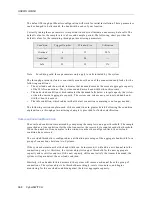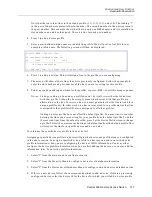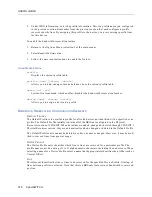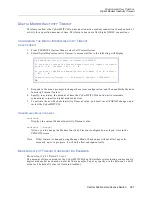
Central Site Remote Access Switch 381
C
ONFIGURING
C
ALL
C
ONTROL
Semipermanent Connections
S
EMIPERMANENT
C
ONNECTIONS
C
ONFIGURATION
E
LEMENTS
D
EVICE
N
AME
Specify the device name (from the Device List) that you wish to make a semipermanent connection.
Once specified, the semipermanent feature will (at least) keep the Initial Data Rate active to the
specified device, as long as it is not prohibited by call restrictions or a physical or configuration
problem. The number of semipermanent devices is limited to the maximum number of calls the
CyberSWITCH supports.
M
AX
R
ETRIES
The maximum number of times the CyberSWITCH will retry a call in the Over Interval time period.
The default is 10.
O
VER
I
NTERVAL
The time period in minutes during which the CyberSWITCH will keep track of the number of
disconnects. For example, a disconnect will occur if the device fails authentication. The timer begins
when the first disconnect occurs, and if the timer expires without reaching the maximum number
of disconnects, the disconnect counter is rest. Otherwise, if the maximum number of disconnect is
reached, then the device is moved to the rejected state. The default is 10 minutes.
S
ESSION
I
NTERVAL
The time period beginning when the device enters the rejected state. When the timer expires, the
device is returned to the trying state and the CyberSWITCH attempts to connect to the device. The
default is 60 minutes. “N/A” appears when the CyberSWITCH will not attempt a call again after a
rejection.
Note:
When the Session Interval is configured, a device can fail authentication, move to the
rejected state, move back to the trying state after the timer expires, and fail authentication
again. This cycle can repeat an infinite number of times, depending on the status of call
restrictions. The CyberSWITCH will not stop this cycle until a call restriction limit his
reached or it is overridden by the system administrator by issuing the
disc device
command.
S
EMIPERMANENT
C
ONNECTIONS
B
ACKGROUND
I
NFORMATION
In many areas, ISDN is tariffed by call, and not by connect time. This feature is ideal for areas like
this. Semipermanent connections allow you to automatically make a connection at startup time,
and keep that connection up at all times.
Although semipermanent connections are up at all times, they are different from dedicated
connections. A dedicated connection is simply a Layer 1 pipe for data. A semipermanent
connection is one or more switched calls made at startup and kept until shutdown.
The sections below provide information concerning how semipermanent connections interact with
other system features.
I
NTERACTIONS
WITH
O
THER
F
EATURES
Call Device Commands
Issuing the
call device
or
disc device
commands will effect the semipermanent connection.
These commands will override the semipermanent connection.
















































